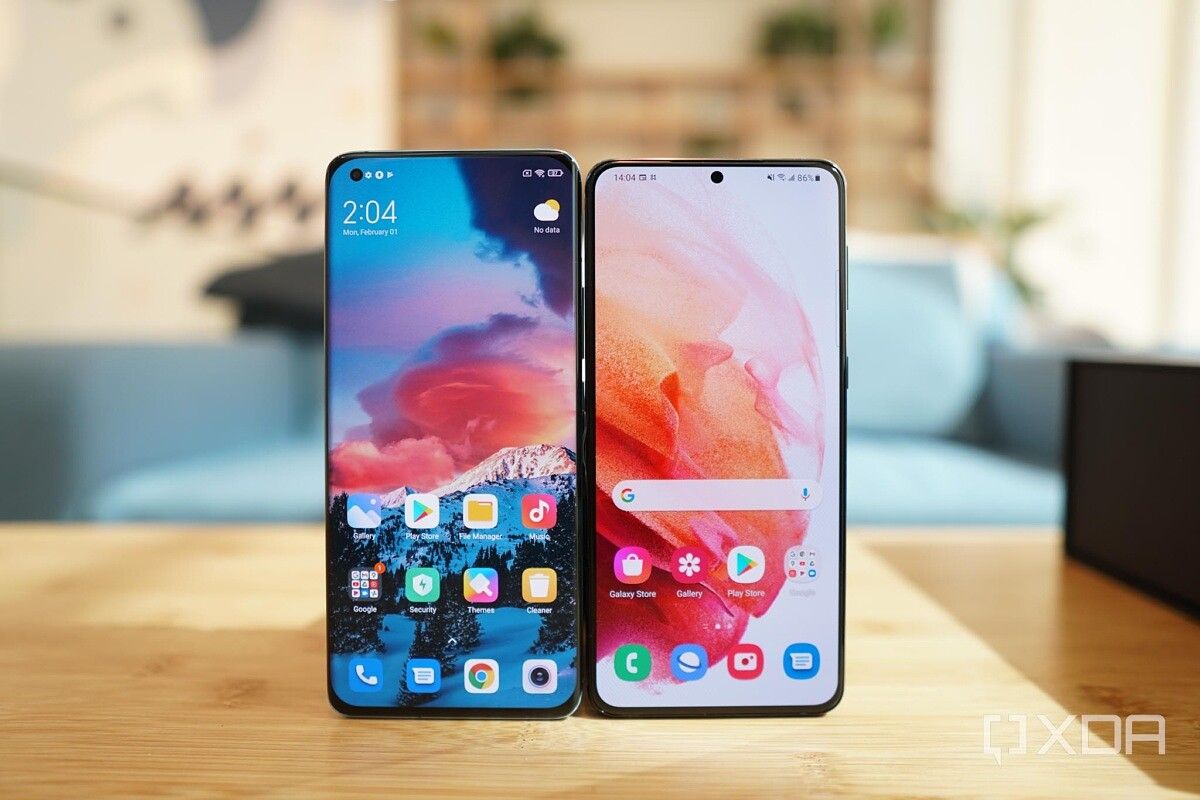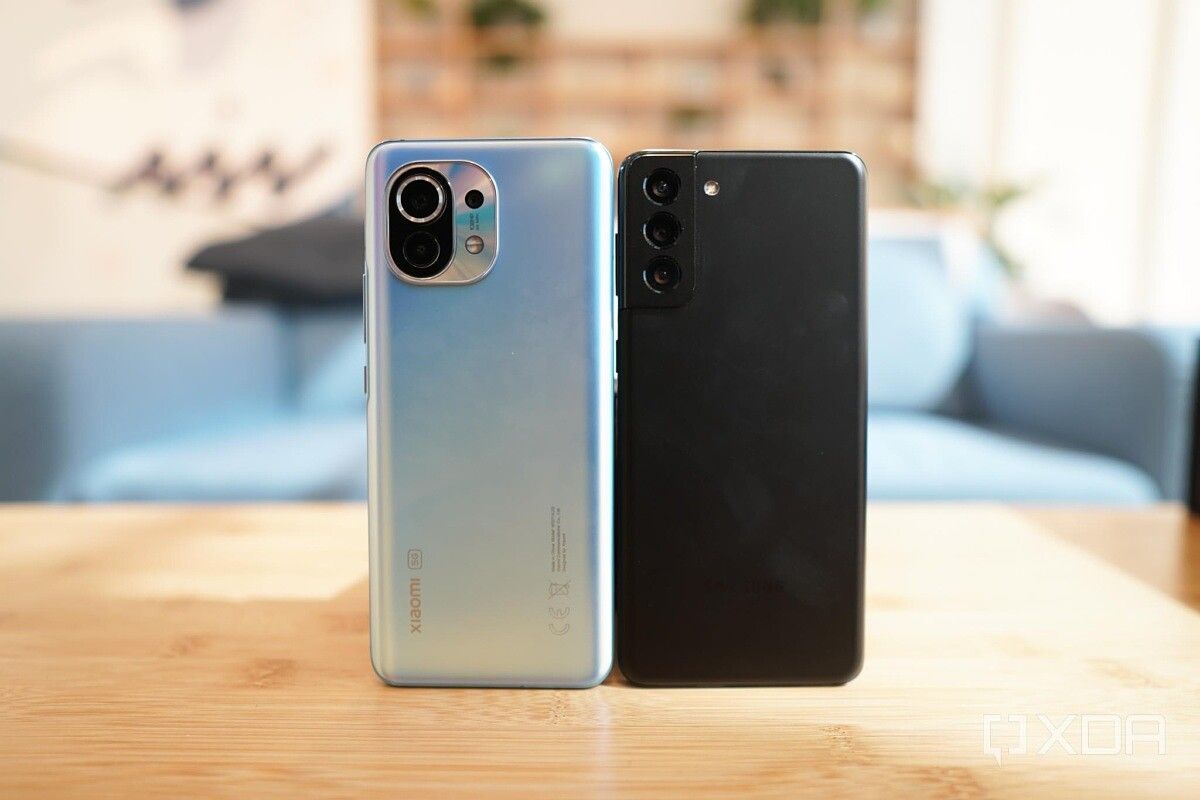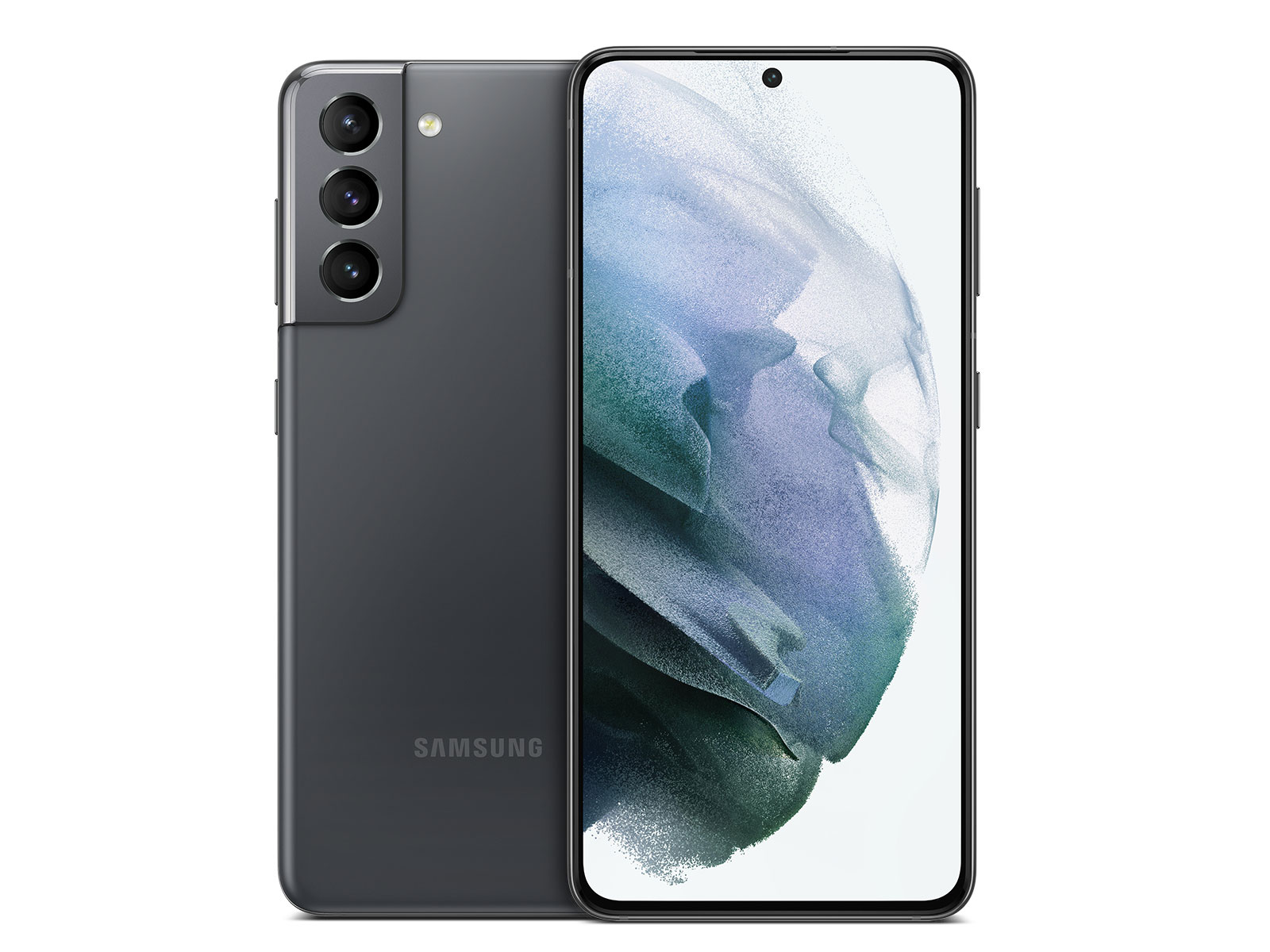Xiaomi has just launched its Mi 11 flagship in Europe, and I’ve been testing the European/International unit for the past four days. Prior to putting my SIM into Xiaomi’s latest, I had been testing the Samsung Galaxy S21 series extensively. So the question I set out to answer when I received Xiaomi’s new phone is: How does the base Xiaomi Mi 11 compare to Samsung’s flagship, particularly the base Galaxy S21 (and also the S21 Plus for good measure)?
I don’t think it’s fair to compare the Xiaomi Mi 11 against the Galaxy S21 Ultra, because the latter is Samsung’s absolute top premium offering, and its pricing reflects that. As of the time of this writing, I don’t know the exact price of each Mi 11 variant in all markets, but we were told that it starts at €749 for the 8GB + 128GB variant. This means for consumers in Europe, the Xiaomi Mi 11 is priced right below the base Samsung Galaxy S21.
Xiaomi Mi 11 versus Samsung Galaxy S21: Specifications
| Specification | Xiaomi Mi 11 | Samsung Galaxy S21 |
|---|---|---|
| Build |
|
|
| Dimensions & Weight |
|
|
| Display |
|
|
| SoC | Qualcomm Snapdragon 888:
Adreno 660 |
|
| RAM & Storage |
|
|
| Battery & Charging |
|
|
| Security | In-Display Optical Fingerprint Sensor | Ultrasonic In-Display Fingerprint Scanner |
| Rear Camera(s) |
Video:
|
|
| Front Camera(s) | 20MP, f/2.4 | 10MP, f/2.2, 1.22µm, 80° FoV, Dual Pixel AF |
| Port(s) | USB 3.2 Type C | USB 3.2 Type-C |
| Audio | Stereo Speakers tuned by Harman Kardon |
|
| Connectivity |
|
|
| Software | MIUI 12.0 based on Android 11 | Samsung One UI 3.1 based on Android 11 |
| Other Features | Simultaneous audio sharing with two Bluetooth devices |
|
Design and hardware: Xiaomi feels more premium
The Xiaomi Mi 11 is a typical sleek glass-and-aluminum sandwich with a 6.8-inch, 120Hz AMOLED screen. While Xiaomi’s display panel doesn’t have the intelligent variable refresh rate of the Galaxy S21 series, its 3,200 x 1,440 resolution (WQHD+) panel is superior to the Galaxy S21 and S21 Plus’ 2,400 x 1,080 panels. Honestly, I believe that 1080p is more than enough for human eyes on a small-ish phone screen, so if I must pick a winner, I’d say the Galaxy S21’s variable refresh rate is a more important feature than the Mi 11’s “more pixels.”

Mi 11 and S21 Plus



Nonetheless, the Xiaomi Mi 11’s screen is awesome. It curves on all four sides (like the Huawei P40 Pro), has a 480Hz touch sampling rate and a 5,000,000:1 color contrast ratio, and supports HDR 10+. I’ve held the Xiaomi Mi 11 side by side with the Samsung Galaxy S21 Ultra (the big dog phone) and both screens look equally gorgeous to my eyes.

Mi 11 and S21 Ultra
The Galaxy S21 and S21 Plus are identical in look but differ in size and back material. The standard Galaxy S21 uses a plastic back (the S21 Plus keeps the glass back). It doesn’t matter that Samsung did a good job to make the plastic not feel plasticky, the reality is the decision to use plastic is a cost-cutting measure by Samsung, so if we’re comparing the Xiaomi Mi 11 to just the standard Galaxy S21, one phone is clearly more premium. The Galaxy S21 Plus fares much better against the Xiaomi Mi 11 in terms of in-hand feel and construction.

The Galaxy S21 and the Mi 11
Inside, the Xiaomi Mi 11 is powered by Qualcomm’s Snapdragon 888, while the Galaxy S21 series uses either Qualcomm’s SoC or Samsung’s own Exynos 2100. All the Galaxy S21 phones I’ve tested were Snapdragon versions, so I have no idea how Exynos 2100 fares against the Snapdragon 888. But the general consensus seems to favor Qualcomm’s SoC. If that’s the case, then the Xiaomi Mi 11 has an SoC advantage in Europe and Southeast Asia, where Samsung ships Exynos-powered devices.
The Galaxy S21 Plus fares much better against the Xiaomi Mi 11 in terms of in-hand feel than the S21
The Galaxy S21 phones are all rated IP68 for water and dust resistance, while Xiaomi’s Mi 11 has no official rating. However, Xiaomi wins the speaker battle: Its stereo speakers, fine-tuned by Harman/Kardon (coincidentally a Samsung subsidiary), pump out noticeably fuller, louder, more vibrant audio than any of the S21 phones.
Moving over to the battery, the Galaxy S21 Plus and S21 pack a 4,800 mAh and 4,000 mAh cell respectively compared to the Xiaomi Mi 11’s 4,600 mAh, but Xiaomi’s battery can be topped up at 55W wired or 50W wireless speeds, while Samsung’s charging speeds feel pedestrian at 25W wired and 15W wireless. Also, contrary to its decision in China, Xiaomi decided to include a 55W charging brick with the Mi 11 in its international packaging; Samsung does not.
Cameras: trading blows
The Xiaomi Mi 11’s camera system consists of a 108MP sensor with a large 1/1.33″ sensor size, along with a 13MP ultra wide-angle camera and a 5MP macro sensor. The Galaxy S21 and S21 Plus have identical camera systems: a 12MP main, 12MP ultra-wide, and a 64MP telephoto.
For still photos, if I’m viewing images on the phone screen or on social media, the Xiaomi Mi 11’s photos look very similar to the Galaxy S21’s photos.




However, if I blow images up to full size and pixel peep on a computer monitor, Xiaomi’s photos are sharper thanks to the Mi 11’s 108MP camera pixel-bins for 27MP shots, while the Galaxy S21 phones just use a rather average 12MP sensor that’s more than a year old.

100% cropped shots, Mi 11 (left), S21 (right).
The script flips for photos after the sun sets: If I’m viewing just on a phone screen, the Xiaomi Mi 11’s shots keep up very well against the Galaxy S21’s, but once I pixel peep, the S21’s night shots tend to be sharper with slightly better dynamic range, because the more pixels you have in a shot, the more light you need.




The ultra wide-angle cameras for the Xiaomi Mi 11 and Galaxy S21/S21 Plus are solid, but not at the level of the best ultra-wide shooters such as the Huawei Mate 40 Pro or even the OnePlus 8 Pro’s 48MP lens. Details are a bit soft if you zoom in, and dynamic range isn’t anywhere as good as their main cameras.


Zooming is where Xiaomi and Samsung decided to compromise in order to both meet a sub-$1,000 price point. The Galaxy S21 and S21 Plus’s so-called telephoto lens is a far cry from the periscopic system seen in the Galaxy S21 Ultra; and Xiaomi’s Mi 11 skips the zoom lens entirely, instead relying on digital crop via the 108MP sensor.
Zoom shot results for both phones are respectable — certainly better than most iPhone zooms — but no match for what the Galaxy S21 Ultra or top Huawei phones can produce. Below are a series of 10x samples. The Xiaomi Mi 11’s shots have slightly better details, but the Galaxy S21’s has better colors.






Video performance is very good for both the Xiaomi Mi 11 and the Galaxy S21 or S21 Plus. All three phones can shoot at up to 8K resolution and produce really stable footage up to 4K/30fps. New this year to the Xiaomi Mi 11 is a series of “Movie Effects” shooting modes, which are basically preset video effects that users can enable within the camera app. Some of these are very fun, including an Inception-like “Parallel World” mode. I am also a huge fan of Xiaomi’s “clone” mode, which can superimpose the same person multiple times into a photo or video, and the results are quite convincing (and fun).
Personally, I find the Xiaomi Mi 11 more fun to play around with for videos.
Software: clean, zippy, full of shortcut gestures
Both Xiaomi’s and Samsung’s phones run a skinned version of Android 11, respectively MIUI 12.0.1 Global (for the Mi 11) and One UI 3.1 (for the Galaxy S21 series). MIUI has a more playful touch, including little software flourishes such as apps “exploding” when being uninstalled, and the phone’s storage capacity being represented by a glass of water that flows along with the orientation. One UI is a bit more business-like and to the point, but does offer tons of customization options if you’re willing to dive deep.
Aesthetics aside, however, they behave very similarly. Since this is the international version of MIUI meant for audiences outside China, it’s got Google support built-in, including Google Assistant as the default voice assistant. There’s even an app tray, which had been missing from Xiaomi phones in years past.
Both MIUI 12 and One UI 3.1 are filled with gesture shortcuts that add to the Android experience, such as the ability to open most apps in a floating window, or double-tapping on the screen to turn the display on or off.





Xiaomi’s Mi 11, in fact, crams more shortcut gestures than most phones I’ve tested, including the ability to launch apps or shortcuts (like turning on the flashlight or opening the QR code scanner) by double-tapping the back of the device or knocking on the screen with a knuckle.
There is one annoying bug in MIUI 12 that’s been around for a couple of years, however: Its one-hand mode can only be activated if the user is using on-screen software buttons and not swipe gesture navigation.
Lastly, in terms of software support, this is one area where Samsung has Xiaomi beat. Samsung has committed to delivering three generations of Android OS updates, while Xiaomi still offers the standard two years of support for its flagship phones.
Performance and battery life: neither lacking in power
Since the Xiaomi Mi 11 and the Galaxy S21 I tested ran on Qualcomm’s Snapdragon 888, I saw no difference in performance. However, the Mi 11 feels “faster” to my eyes, although it’s just an illusion — Xiaomi’s MIUI’s animations simply zip around faster. In my opinion, 120Hz on the Mi 11 feels slightly zippier/snappier than 120Hz on the Galaxy S21 phones, including the Ultra.
That’s just my opinion, however. In a more objective comparison, I find the Galaxy S21 and S21 Plus have far better battery life than the Xiaomi Mi 11 thanks to the former having less pixel-dense screens that can adjust their refresh rates depending on the content, whereas for the Mi 11, my phone ran at 120Hz and WQHD+ resolution most of the time.
In fact, battery life may be an issue for the Mi 11, as the phone hasn’t been able to last more than 11 hours away from a charger in any of the days I’ve had the phone. The Galaxy S21 and S21 Plus can last the entirety of a 14-hour day for me easily.
Conclusion: none of these phones are true premium flagships, but one comes closer
A recent trend that’s been established in the mobile scene is that there are flagship phones, and then there are premium flagship phones. The former usually already have the latest SoC, beautiful screen, and capable cameras, but the latter just has those extra bells and whistles and all the bleeding-edge components.
No one is going to confuse a plastic back, 1080p flat panel phone as a premium flagship

The Xiaomi Mi 11 is in an interesting place because most of its components, from the 120Hz WQHD+ screen to the 108MP camera to the curvy-aluminum body put it in the premium flagship tier, but its lack of zoom lens keeps it from being one. It’s a phone that flirts with premium flagship status but ultimately ends up being slightly below that.
Samsung’s non-Ultra S21 phones, particularly the standard Galaxy S21, are more firmly entrenched in where they stand: No one is going to confuse a plastic back, 1080p flat panel phone as a premium flagship. In other words, the Xiaomi Mi 11 is slightly more premium than the Galaxy S21 or S21 Plus while undercutting both in price.
Samsung Galaxy S21 Forums ||| Samsung Galaxy S21+ Forums ||| Samsung Galaxy S21 Ultra Forums
If you live in a region where Xiaomi’s phones are sold officially (that would be most of the world outside of North America), then the Xiaomi Mi 11 is likely a better value than the standard Galaxy S21 and S21 Plus. If you have a bit more money to spend and want something a bit more premium, then your best option is the Galaxy S21 Ultra. However, rumors suggest Xiaomi will launch a Mi 11 Pro and possibly a Mi 11 Pro+ (or Mi 11 Ultra?) in the near future, so it might be worth waiting a bit to see what’s in store.
- With the Mi 11, Xiaomi has once again delivered a stellar combination of flagship hardware at a competitive price.
- While the Galaxy S21 doesn't have all the bells and whistles that the S21 Ultra offers, it's still a compelling smartphone with flagship-tier hardware.
The post The Xiaomi Mi 11 is a better buy than the Samsung Galaxy S21 appeared first on xda-developers.
from xda-developers https://ift.tt/2YSPCPA
via IFTTT


Aucun commentaire:
Enregistrer un commentaire